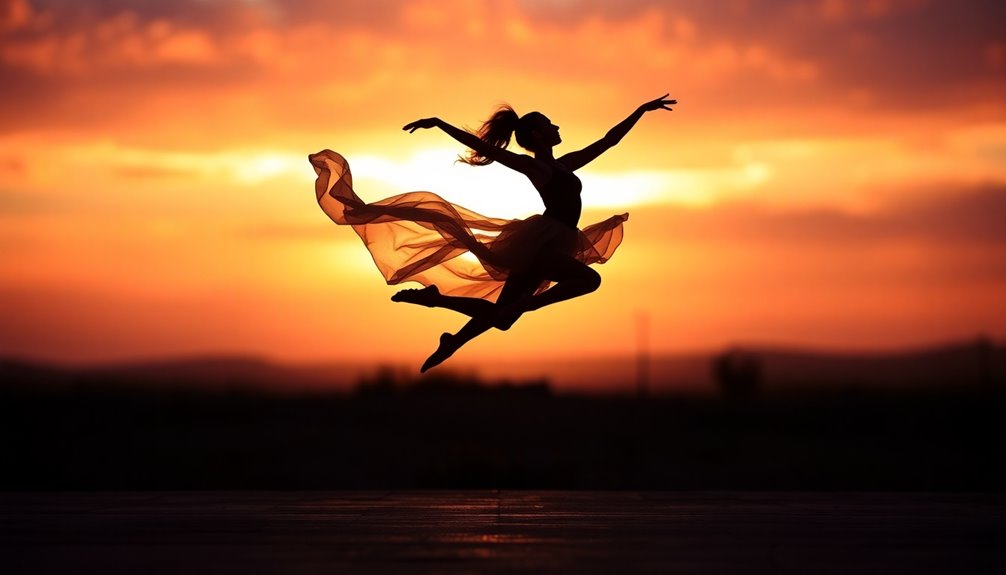Dance showcases themes like cultural expression, emotional storytelling, and artistic evolution. You see how it connects generations and promotes unity through various styles, from ancient rituals to contemporary forms. The choreography you experience blends rhythm and movement, creating powerful narratives. Each performance captures the essence of human emotion, inviting you to feel and interpret. The collaborative nature of dance also reflects teamwork and community building. As you explore the art of movement, you uncover deeper meanings and the intricate design that shapes every performance, revealing even more about this vibrant form of expression.
Key Takeaways
- Dance embodies themes of cultural expression, reflecting societal values, traditions, and communal narratives through varied movement styles and performances.
- Emotional storytelling is central to dance, where gestures and body language convey complex feelings and experiences, connecting performers and audiences.
- Ritual and spirituality often influence dance, historically serving as a bridge to the divine and expressing beliefs through movement and choreography.
- The theme of collaboration is vital, as dance integrates music, design, and various artistic elements, enhancing the overall narrative and emotional impact.
- Social change and community building are significant themes, with dance fostering emotional well-being, teamwork, and discipline while promoting cultural exchange and unity.
Definition and Cultural Significance
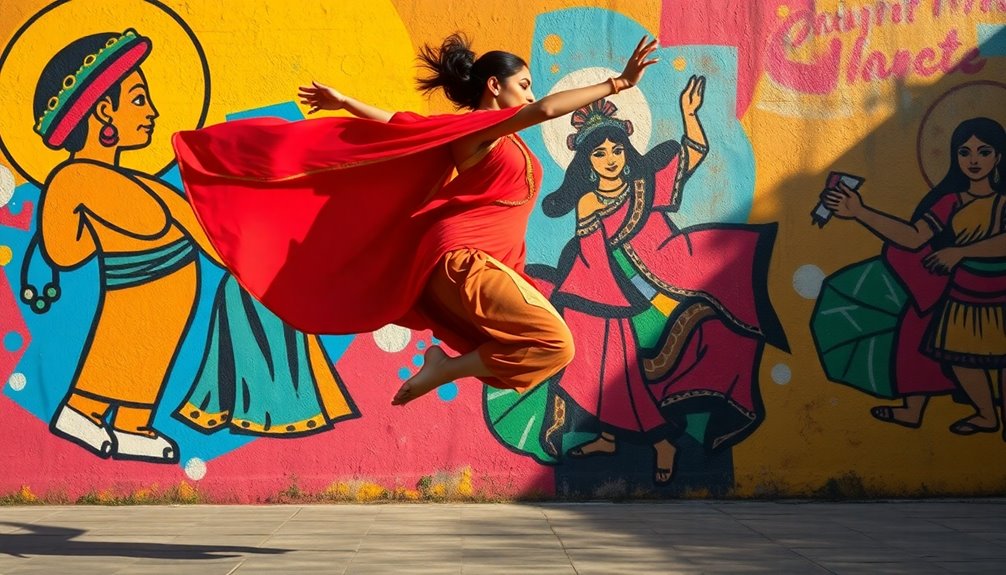
Dance, a vibrant expression of culture and emotion, serves as a powerful narrative tool that conveys stories and historical moments. For over 9,000 years, it's been a crucial aspect of human expression, with origins tracing back to ancient rituals in places like India and Egypt.
Various dance forms, from ballet to hip-hop, reflect the societal and cultural changes throughout history, connecting generations and communities. You'll find that dance acts as a social art form, promoting cultural exchange and unity.
Popular television shows have brought dance into the spotlight, showcasing its ability to engage and inspire. Through festivals and performances, dance provides a freeing experience, allowing you to express yourself while celebrating diverse traditions and shared human experiences.
Choreography and Movement Techniques

Choreography transforms movement into a mesmerizing narrative, weaving together various styles to create a cohesive performance.
By understanding different movement techniques, you can better appreciate how the human body expresses emotions and stories. Here are three key aspects to reflect upon:
- Diversity of Styles: Each dance style, from ballet's pliés to hip-hop's breaking, showcases unique movement vocabulary that enriches performances.
- Rhythm and Musicality: Mastering rhythm is essential; it allows you to execute movements with precision and connect with the audience on a deeper level.
- Innovative Approaches: Choreographers like Martha Graham and George Balanchine revolutionized dance by integrating contemporary techniques and technology, pushing the boundaries of movement and expression.
Explore these elements to deepen your understanding of choreography and movement techniques!
Historical Evolution of Dance
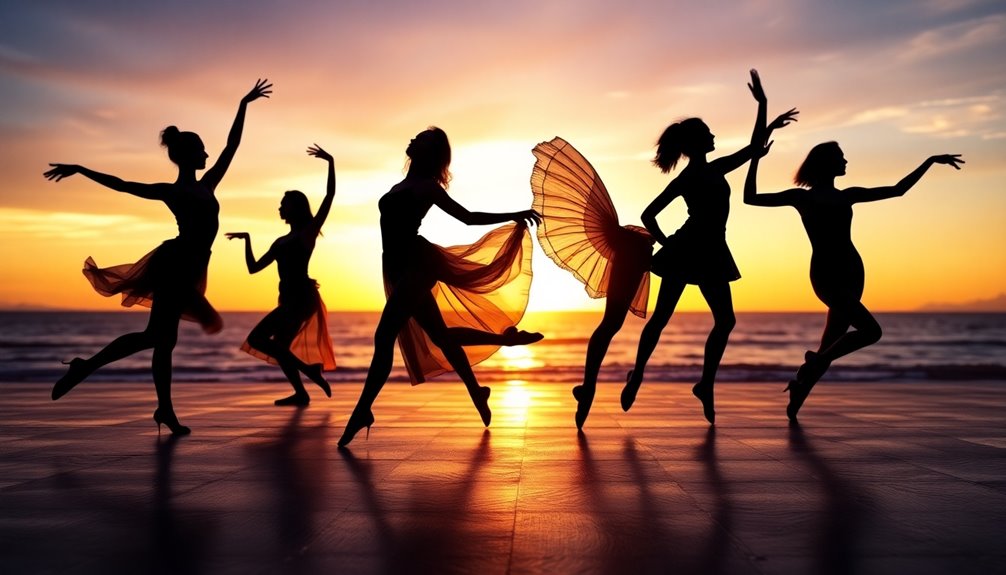
When you look back at the historical evolution of dance, you'll find its roots in ancient rituals and celebrations that date back over 9,000 years.
The Renaissance brought ballet into the spotlight, setting the stage for structured dance forms.
As you move into the 20th century, you'll see modern dance innovations reflecting the changing social landscape, showcasing how dance continues to adapt and resonate through time.
Ancient Rituals and Celebrations
Although ancient civilizations often engaged in various forms of expression, dance stood out as a powerful medium for connecting with the divine and celebrating life's milestones. These early practices weren't just for enjoyment; they played an essential role in society.
- Rituals: Dance served as a bridge to the divine, allowing communities to express their beliefs and values through movement.
- Celebrations: During significant events like harvest festivals, dance fostered community bonds, expressing collective joy and gratitude.
- Storytelling: Many dances conveyed historical narratives, intertwining music and movement to pass down cultural traditions.
As you explore the significance of dance in ancient rituals and celebrations, you'll appreciate its enduring impact on human culture and connection.
Renaissance Ballet Formalization
As the Renaissance blossomed, dance evolved into a refined art form, with ballet emerging as a structured practice that combined movement, music, and storytelling.
This period, spanning from the 14th to the 17th century, saw the formalization of ballet, characterized by intricate choreography and professional dancers. Influenced by the revival of classical antiquity, ballet became a human form of art that beautifully expressed the ideals of harmony and beauty.
The first known ballet, "Ballet Comique de la Reine," performed in 1581, showcased elaborate costumes and narrative techniques, setting a precedent for future works.
Figures like Catherine de Medici championed ballet in the French court, using it to tell stories and convey social and political messages, paving the way for its theatrical evolution.
Modern Dance Innovations
Modern dance innovations emerged in the early 20th century, challenging the rigid structures of classical ballet and inviting dancers to explore their individual expressions.
Pioneers like Martha Graham and Isadora Duncan emphasized emotional depth and dynamic movement, prioritizing personal narratives over technical perfection. This genre also adapted to significant historical events, mirroring societal changes and cultural shifts.
Here are three key elements of modern dance innovations:
- Element of Energy: Dancers express emotions through varying levels of energy and intensity.
- Improvisation: Choreographers embraced spontaneity, allowing for unique performances.
- Multimedia: The integration of technology enhances storytelling, creating immersive experiences.
These innovations continue to shape the landscape of contemporary dance, pushing boundaries and redefining movement.
Collaborative Aspects of Dance
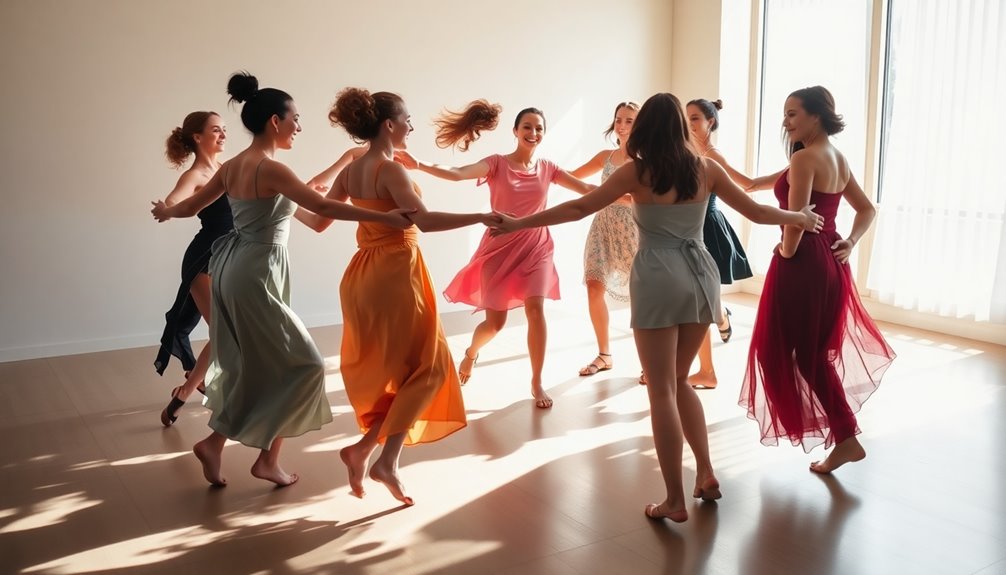
While many may see dance as a solo endeavor, it's fundamentally a collaborative art form that thrives on the integration of various creative elements. Dancers use music, stage design, and costumes to enhance their performances, creating a richer experience for the audience.
Notable collaborations throughout history, like those with Coco Chanel and Anish Kapoor, showcase the synergy between dance and other artistic disciplines. The choreography process often involves spontaneous improvisation alongside meticulous design, reinforcing the need for cooperation among dancers, choreographers, and creative professionals.
Influential choreographers draw inspiration from visual artists, as seen in works by Edgar Degas and Wassily Kandinsky, highlighting the collaborative aspects of dance. This integration guarantees that dance remains a vibrant and evolving art form.
Social Impact of Dance
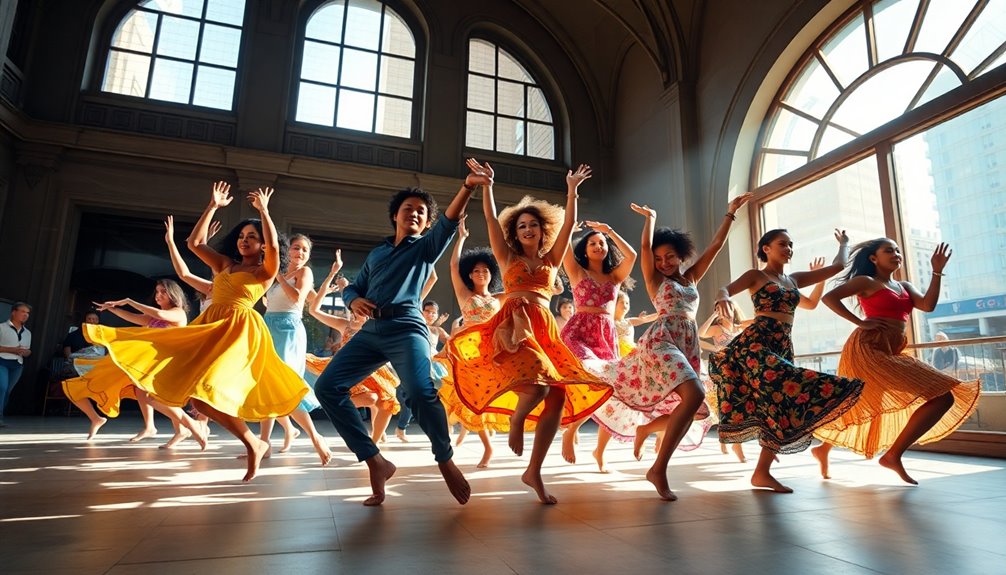
Dance isn't just an art form; it's a catalyst for social change and community building. When you engage in dance, you're participating in a powerful artistic practice that fosters connection and celebrates diversity.
Here are three key ways dance impacts society:
- Emotional Well-Being: Dance activities enhance your mood, providing stress relief and boosting creativity.
- Personal Development: Through dance education, you gain discipline, teamwork, and essential social skills that benefit your life beyond the studio.
- Community Engagement: Competitions and public performances create opportunities for various groups to come together, appreciating the art of dance and promoting cultural understanding.
Artistic Techniques in Dance
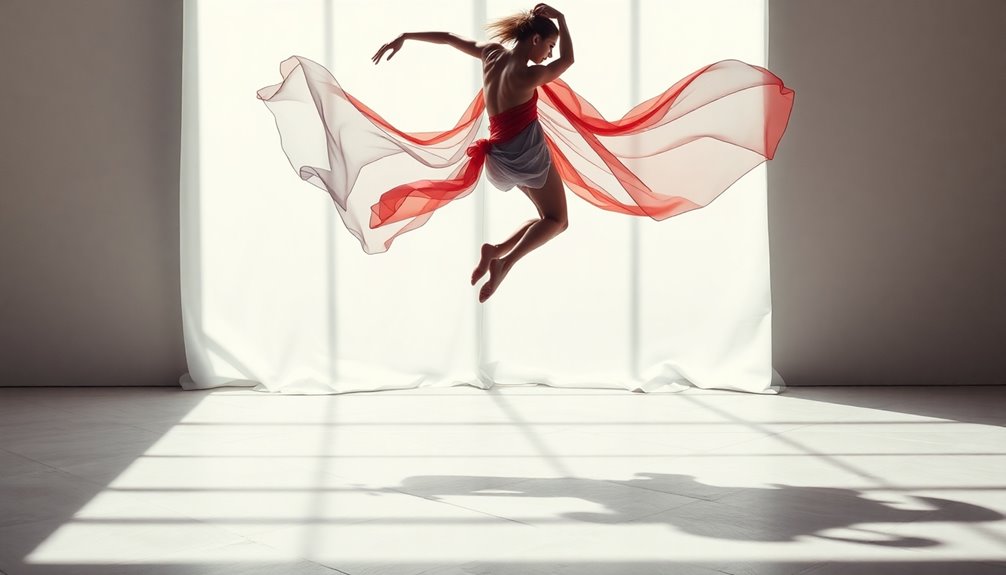
When you consider artistic techniques in dance, think about how movement representation can tell a story or evoke emotions.
You'll notice how expressive use of space and clever manipulation of rhythm and timing enhance the overall impact of a performance.
These elements combine to create an enchanting experience that resonates with the audience.
Movement Representation Techniques
Movement representation in dance employs a variety of artistic techniques that effectively convey emotion and narrative. By manipulating body shapes and dynamics, dancers create a powerful visual language.
Here are three key techniques you can explore:
- Dynamic Poses: Artists like Sarah Jil Niklas capture the energy of movement through dynamic poses, illustrating tension and unity without a specific scene.
- Geometric Forms: Wassily Kandinsky reduces bodies to simple geometric shapes, emphasizing the structural interplay of color and line in movement representation.
- Monochrome Backgrounds: Alex Katz uses monochrome settings to highlight the dynamics of a dancer's movements, enhancing the emotional impact of their gestures.
These techniques show how body, space, and emotion intertwine, enriching your understanding of dance as a narrative art form.
Expressive Use of Space
While exploring the expressive use of space in performance, you'll find that the area surrounding a dancer plays an essential role in conveying emotion and narrative. Space encompasses various elements like levels, directions, and pathways, creating a rich visual dynamic.
Your body parts become instruments of expression as you fill the kinesphere—utilizing near reach, mid-range, and far reach to explore spatial relationships. By manipulating personal and expansive space, you can evoke intimacy or broad storytelling, considerably affecting audience perception.
Choreographers enhance this by crafting visual patterns through dancer interactions, making larger movements dramatic while smaller ones capture subtler emotions.
Ultimately, the effective use of space transforms your performance into a compelling narrative, resonating deeply with viewers.
Rhythm and Timing Elements
Rhythm and timing are essential elements that shape the character of a dance performance. The pulse of the music influences how dancers move, creating a flow that captivates the audience.
Understanding rhythm and timing can elevate your dance experience in several ways:
- Metered vs. Free Rhythm: Know the difference between structured patterns and spontaneous movements, and how each affects your performance.
- Tempo Variations: Recognizing fast, moderate, and slow tempos helps convey distinct emotional qualities in your dance.
- Syncopation: Embrace off-beat accents to add complexity and unexpected dynamics in choreography, enhancing your dance's impact.
Mastering these elements guarantees that every time you step onto the floor, you embody both the rhythm and the timing of the music.
Elements of Dance Explained
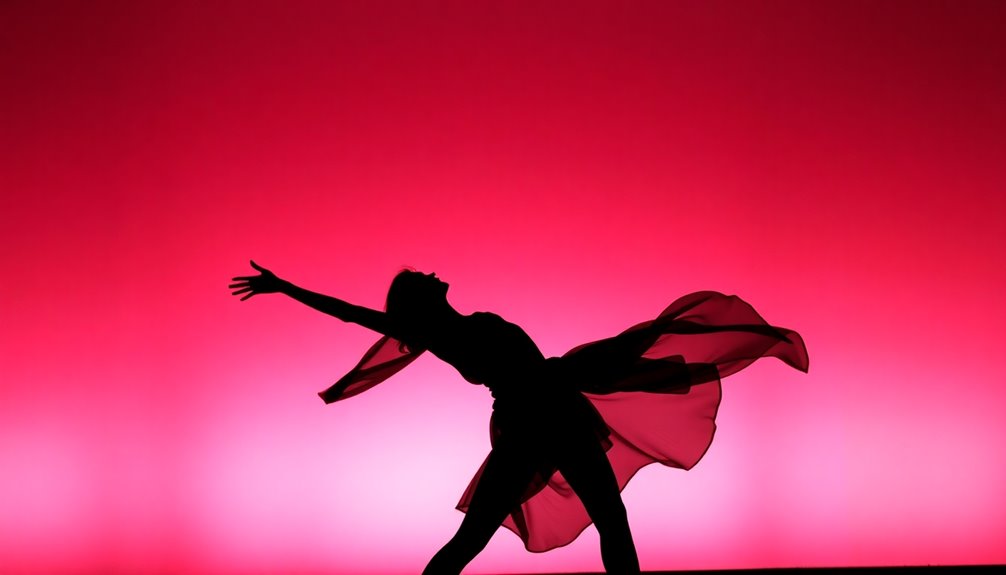
Dance is a vibrant expression that relies on five core elements: Body, Action, Space, Time, and Energy.
The Body serves as the instrument for movement, allowing for locomotor actions like walking and jumping, as well as non-locomotor actions such as twisting and bending.
Space is essential; it includes levels, directions, and pathways that enhance your performance's visual and emotional impact.
Time governs the rhythmic quality of your dance, influencing speed and timing relationships.
Finally, Energy reflects the effort behind each movement, with dynamic qualities like sustained, percussive, and vibratory actions affecting the emotional resonance of your performance.
Together, these elements create a rich tapestry that brings your dance to life.
Body and Movement Dynamics
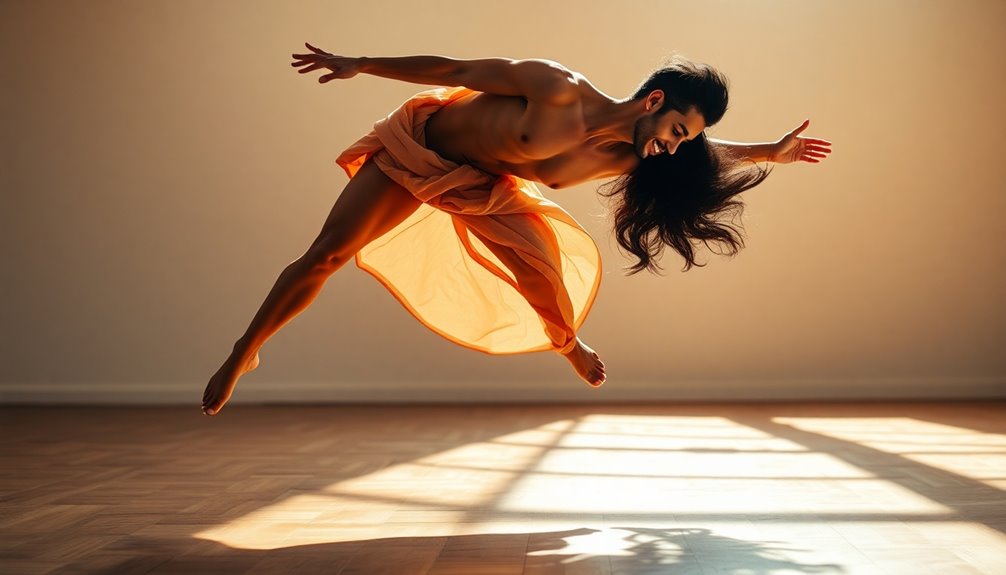
Understanding the elements of dance naturally leads to exploring the intricate dynamics of body movement. Dancers use their bodies as expressive instruments, employing various locomotor and nonlocomotor movements to share emotions.
Mastering body dynamics is vital for manipulating space, timing, and energy, which creates impactful performances.
Here are three key aspects to reflect on:
- Body Control: Exceptional balance and agility are essential for executing complex phrases.
- Breath: It influences the flow of movement, adding emotional depth.
- Spatial Awareness: Exploring body shapes enhances your understanding of both positive and negative spaces while moving through SPACE.
Time and Space in Dance
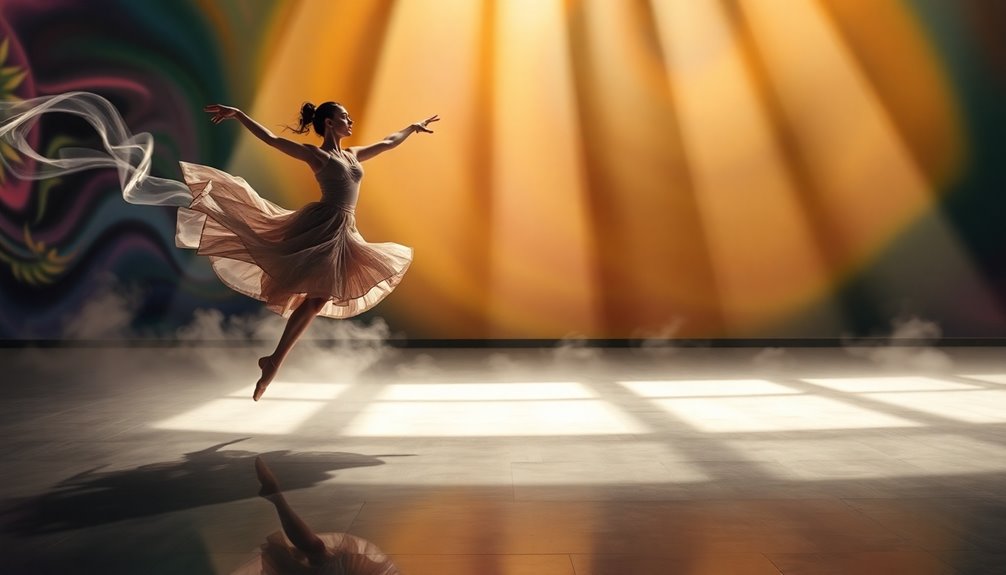
While exploring the art of movement, you'll find that time and space are essential elements that shape a dance performance. Time refers to the unfolding of movements, incorporating pulse, speed, and rhythm. Space dynamics involve the area of performance, considering personal versus expansive settings and levels. Understanding these concepts enhances choreography and storytelling.
| Element | Description | Importance |
|---|---|---|
| Time | Pulse, speed, rhythm patterns | Affects flow and expression |
| Space | Area, levels, directional changes | Creates visual interest |
| Kinesphere | Dancer's three-dimensional space | Enhances movement categorization |
Choreographers manipulate these elements through various pathways and timing relationships, making each performance unique and enchanting.
Frequently Asked Questions
What Are the Themes in Dance Dance Dance?
In "Dance Dance Dance," you'll find themes of identity and personal expression woven throughout the choreography. As dancers improvise, they reveal genuine emotions, inviting you to connect with their stories.
You'll notice how diverse styles, like contemporary and hip-hop, create a rich tapestry of movement that transcends cultural boundaries. The visual elements, including costumes and lighting, enhance the experience, while the rhythm of the music guides both dancers and viewers on an emotional journey.
What Are the Elements of Dance Exploration?
When you explore the elements of dance, you engage with Body, Action, Space, Time, and Energy.
You can move your body in various ways, whether traveling across the floor or staying in place. Consider how you occupy space, using levels and directions to enhance your performance.
Pay attention to the rhythm and speed of your movements, and let the energy reflect your emotions. Each component shapes your expression and interpretation in dance.
Is Dance the Art of Movement?
Yes, dance is definitely the art of movement. When you move your body, you express emotions, tell stories, and connect with culture.
Each gesture, whether traveling or stationary, carries meaning and energy. You can explore rhythm and musicality through choreography, creating a visual feast for your audience.
What Is a Theme in Dance?
A theme in dance is the central idea that shapes the choreography.
It's what guides your movements, emotions, and storytelling. When you choose a theme, you're creating a lens through which the audience experiences your performance.
Whether it's love, conflict, or joy, each theme adds depth and meaning.
You'll find that exploring different themes not only enhances your dance but also connects you more deeply with your audience.
Conclusion
In exploring the themes of dance, it's clear that movement is more than just a physical expression; it's a powerful form of communication intertwined with culture and emotion. You might think dance is just for performers, but everyone can connect with its rhythms and stories. Picture a lively gathering where strangers become friends through shared movements—this illustrates how dance breaks barriers and fosters unity. So, whether you dance or simply watch, you're part of this vibrant art form!
